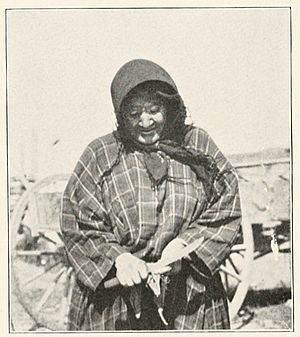Buffalo Bird Woman facts for kids
Quick facts for kids
Buffalo Bird Woman
|
|
|---|---|
| Hidatsa: Maaxiiriwia | |

Maxi'diwiac, Photographed in 1910
|
|
| Hidatsa leader | |
| Personal details | |
| Born | ca. 1839 Knife River, North Dakota |
| Died | 1932 Fort Berthold Reservation, North Dakota |
| Relations | Brother, Henry Wolf Chief; grandmother, Otter; adopted grandmother, Turtle |
| Children | Edward Goodbird |
| Parents | Father, Small Ankle, mother, Want-to-be-a-woman; stepmothers, Red Blossom and Strikes-many-women |
| Known for | Recording Hidatsa gardening, agriculture, and culture |
Waheenee, also known as Buffalo Bird Woman (born around 1839, died 1932), was an important Hidatsa woman. She lived on the Fort Berthold Reservation in North Dakota. Her Hidatsa name was Waheenee, but she was also called Maaxiiriwia. This means Buffalo Bird Woman.
She was known for keeping the traditional Hidatsa way of life. This included gardening, cooking, and daily household tasks. She shared her culture's traditions and stories. She did this through interviews with Gilbert Wilson. She told him about her own life and the work of Hidatsa women.
Contents
Buffalo Bird Woman's Life Story
Her Early Life and Family
Waheenee was born to Want-to-be-a-woman and Small Ankle. Both were from the Native American Hidatsa tribe. We don't know her exact birth date, but it was likely around 1839. She also had a brother named Wolf Chief.
In 1837, a smallpox sickness spread. After this, the Hidatsa people moved. In 1845, they settled in a new place called Like-a-Fishhook Village in North Dakota. Waheenee was four years old then. The Mandan tribe joined them, and later the Arikara tribe in 1863. These three tribes together are known as the Three Affiliated Tribes.
When Waheenee was six, her mother died from another smallpox outbreak. After this, her grandmother Turtle raised her. Her great-grandmother's adopted daughter, Otter, also helped.
Waheenee received her official name, Waheenee, at a special ceremony when she was ten. However, her father, Small Ankle, started calling her Maaxiiriwia. This name means Buffalo Bird Woman. This is the name she is most known by today.
Her Adult Years
Waheenee married two times. Her first husband, Magpie, died from tuberculosis. Later, she married Son-of-a-star. In 1869, they had their only child, Tsaka'kasakic. He was commonly known as Edward Goodbird.
Around 1885, the tribes started moving to land along the Missouri River. This area became known as the Fort Berthold Reservation.
Waheenee spent most of her adult life on this Reservation. She lived with the Three Affiliated Tribes. She gardened using traditional Hidatsa farming methods her whole life. She never learned to speak English. Her brother, Wolf Chief, learned English and became a Christian. He added Henry as his first name.
Buffalo Bird Woman's Garden Book
Waheenee became known to a wider audience through her son, Edward Goodbird. Edward went to mission school and became a pastor. He could speak four languages. He met a researcher named Gilbert Wilson, who visited Fort Berthold in 1906. Between 1907 and 1918, Wilson interviewed Waheenee, Henry Wolf Chief, and Edward Goodbird.
The talks with Waheenee became the main part of Wilson's important book. It was called Buffalo Bird Woman's Garden: Agriculture of the Hidatsa Indians. Wilson published this book in 1917.
Buffalo Bird Woman's Garden is the work that made Waheenee famous. The book shares information from Buffalo Bird Woman about how the Hidatsa harvested their crops. Wilson conducted and edited the interviews. Edward Goodbird helped by translating.
Most of Wilson's book teaches readers about Hidatsa farming methods. But the interviews covered other topics too. Buffalo Bird Woman also talked about her tribe's origin myths, their history, and cultural practices. The book also has photos of an older Waheenee gardening. Edward Goodbird's drawings of maps and Hidatsa farming tools are also included. These drawings were based on Waheenee's own tools.
Wilson kept Waheenee's interviews and stories mostly as she told them. He explained in the book's introduction: "It is an Indian woman's interpretation of economics; the thoughts she gave to her fields; the philosophy of her labors." Wilson hoped his book would help people understand and treat all Native Americans better.
What's in the Book?
The book Buffalo Bird Woman's Garden includes these chapters:
- Foreword
- Chapter I- Tradition
- Chapter II- Beginning a garden
- Chapter III- Sunflowers
- Chapter IV- Corn
- Chapter V- Squashes
- Chapter VI- Beans
- Chapter VII- Storing for winter
- Chapter VIII- The making of a drying stage
- Chapter IX- Tools
- Chapter X- Fields as Like-a-Fishhook Village
- Chapter XI- Miscellanea
- Chapter XII- Since the white men came
- Chapter XIII- Tobacco
Other Books About Waheenee
Gilbert Wilson wrote more books about the Hidatsa people. Goodbird the Indian, published in 1914, shares more about her son's life. Waheenee: An Indian Girl's Story, Told by Herself, published in 1921, is an autobiography. It tells the story of Waheenee and Goodbird. These books were also created from recorded interviews.
Buffalo Bird Woman's Legacy
Today, Waheenee is remembered for her stories of traditional Hidatsa life. Her gardening techniques are also still important. Copies of Buffalo Bird Woman's Garden are still available to buy. A newer version was released in 1987. It includes a new introduction by an expert named Jeffery R. Hanson. You can also read Buffalo Bird Woman's Garden for free online.
Even though the book is not as widely known today, people who read it praise its historical value. They also find the gardening information still useful.
A children's picture book, Buffalo Bird Girl: A Hidatsa Story, was published in 2012. S.D. Nelson wrote it. The book uses Wilson's work to create a fictional story about Waheenee's childhood.
Books by Buffalo Bird Woman
- Buffalo Bird Woman. Buffalo Bird Woman's Garden: Agriculture of the Hidatsa Indians. St. Paul: Minnesota Historical Society Press, 1987. ISBN: 978-0-87351-219-0.
- Buffalo Bird Woman. Waheenee, an Indian girl's story. Lincoln: University of Nebraska Press, 1991.


